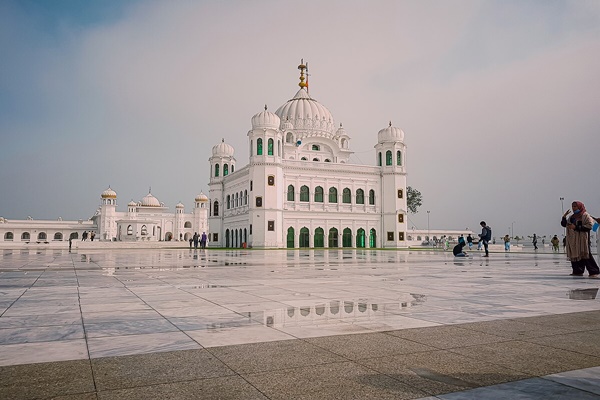5 Years of Kartarpur Sahib Corridor (GS Paper 1, Culture)

Introduction
- November 9, 2024, marks the five-year anniversary of the Kartarpur Sahib Corridor, a significant initiative between India and Pakistan aimed at facilitating religious tourism and strengthening people-to-people ties.
- This corridor connects Gurdwara Darbar Sahib Kartarpur in Pakistan to Gurdwara Dera Baba Nanak in India, allowing Sikh pilgrims to visit one of the holiest sites in Sikhism without requiring a visa.
- The corridor stands as a symbol of religious unity and is a major step in facilitating access to the resting place of Guru Nanak Dev Ji, the founder of Sikhism.
Background and Historical Context
- The Kartarpur Sahib Corridor was initially proposed during the 1999 Delhi-Lahore Bus diplomacy by then Prime Ministers of India and Pakistan, Atal Bihari Vajpayee and Nawaz Sharif.
- The idea was to create a corridor for Sikh pilgrims to visit Gurdwara Kartarpur Sahib, located on the banks of the Ravi River in Pakistan’s Narowal district, where Guru Nanak Dev Ji spent his final years.
- In 2019, to commemorate the 550th birth anniversary of Guru Nanak Dev Ji, Prime Minister Narendra Modi inaugurated the Kartarpur Sahib Corridor on November 9, marking a historic step for religious freedom and cross-border connectivity between the two nations.
Key Features of the Kartarpur Sahib Corridor
- Visa-Free Access: The corridor allows Indian Sikh pilgrims to visit the Gurdwara Kartarpur Sahib in Pakistan without requiring a visa. This was a groundbreaking decision, as it eases the travel process for devotees and fosters religious tourism.
- Religious Significance: The Gurdwara Darbar Sahib Kartarpur, situated in Pakistan’s Narowal district, is one of the most sacred places for Sikhs. It is the site where Guru Nanak Dev Ji spent the last 18 years of his life and is deeply revered as the center of his spiritual teachings.
- Connectivity: The corridor connects Gurdwara Dera Baba Nanak in the Indian Punjab (Gurdaspur district) to Gurdwara Darbar Sahib Kartarpur in Pakistan, facilitating smooth cross-border access.
- Strategic Importance: It promotes peace and mutual understanding between India and Pakistan, two nations with a complex political relationship. The corridor serves as a humanitarian bridge, symbolizing the potential for cooperation and dialogue.
- Agreement Renewal: In 2024, both India and Pakistan extended the Kartarpur Sahib Corridor Agreement for another five years, reaffirming the commitment to the corridor’s operation and access.
Guru Nanak Dev Ji: The Visionary
Guru Nanak Dev Ji (1469-1539), the founder of Sikhism, is one of the most revered spiritual figures in the world. Born in Nankana Sahib, near Lahore (modern-day Pakistan), Guru Nanak’s teachings transcended religious boundaries, advocating for the unity of humanity and the worship of one God.
Key aspects of Guru Nanak's life and beliefs include:
- Interfaith Dialogue: Guru Nanak Dev Ji initiated interfaith dialogue, engaging with different religious denominations of his time, including Hindus, Muslims, and others. His vision was one of unity, compassion, and tolerance, challenging dogmas and rituals that divided people.
- The Guru Granth Sahib: Guru Nanak’s written compositions were included in the Adi Granth, which was compiled by Guru Arjan, the fifth Sikh Guru. This collection later became known as the Guru Granth Sahib, the holy scripture of Sikhism, and is considered the eternal Guru by Sikhs.
- Nirguna Bhakti: Guru Nanak advocated for Nirguna Bhakti, the worship of a formless God. He rejected idol worship, sacrifices, ritual baths, and austerities, focusing instead on devotion through meditation and prayer.
- Sangat and Seva: Guru Nanak established the practice of congregational worship (Sangat) and emphasized Seva (selfless service). His teachings encouraged community support and collective participation in religious rituals and social welfare.
- Succession of Gurus: Guru Nanak Dev Ji appointed his disciple, Guru Angad, as his successor, establishing the line of ten Sikh Gurus, a tradition that continued for over 200 years.
The Kartarpur Sahib Corridor's Legacy
- The Kartarpur Sahib Corridor not only serves as a religious route but also carries immense cultural and historical significance.
- It stands as a testament to the teachings of Guru Nanak Dev Ji, who promoted peace, tolerance, and interfaith understanding.
- The corridor helps Sikh devotees from India visit the site where their Guru lived and preached, fostering a sense of spiritual connection and unity.
Challenges and Prospects
Despite its significant potential for strengthening ties, the Kartarpur Sahib Corridor faces several challenges:
- Political Tensions: Given the strained relations between India and Pakistan, maintaining the continuity and security of the corridor has been challenging at times. Both countries have to manage sensitive diplomatic issues, which sometimes affect the smooth operation of the corridor.
- Logistical Issues: Managing the large number of pilgrims, especially during peak religious events, requires effective coordination between both countries. Infrastructure and immigration processes also need to be streamlined to accommodate growing traffic.
Conclusion
- The Kartarpur Sahib Corridor is a shining example of how religion and diplomacy can intersect to promote peace, understanding, and cooperation between neighboring countries.
- As it celebrates its five-year anniversary, the corridor has become more than just a passage for religious tourism; it has emerged as a symbol of hope for greater dialogue and mutual respect between India and Pakistan.
- The extension of the corridor agreement reflects both countries' commitment to preserving this vital connection, which is an embodiment of Guru Nanak Dev Ji's teachings of harmony and unity.


